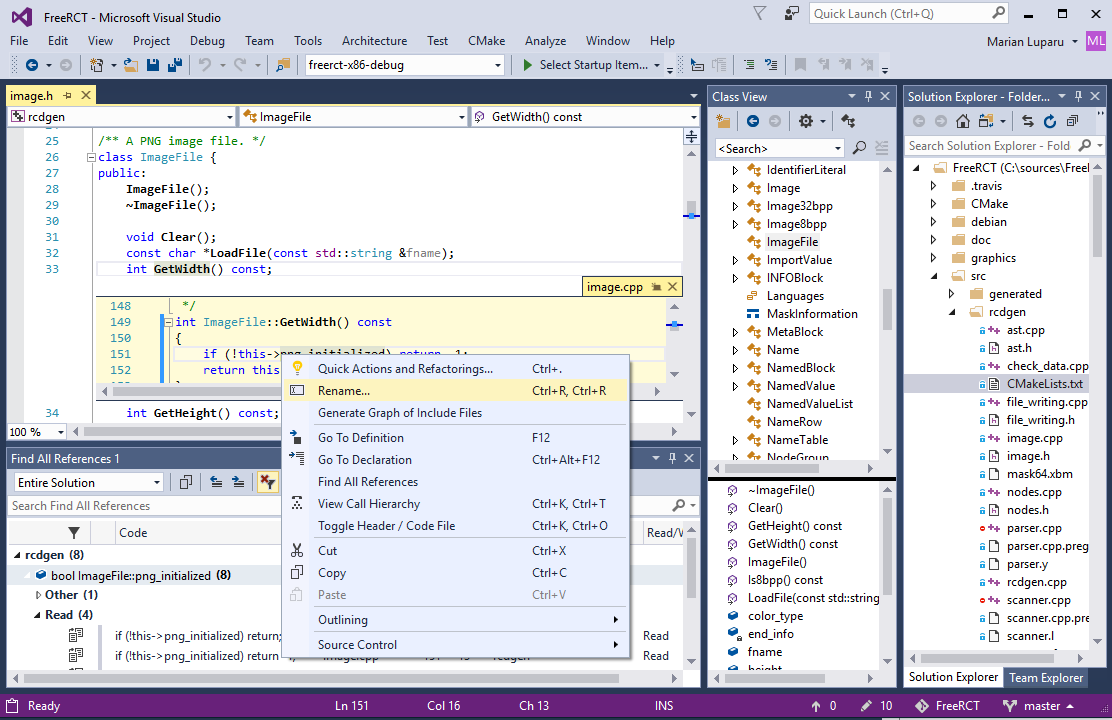

Set Properties->Debugging->Command Arguments to 200 Install and Run

⚠ Since this example takes a command line argument, to run/debug it from Visual Studio, the properties on the executable project ( app) must be set. This will ensure that the executable can be launched from the debugger and will find all the dependent libraries. But you can set the RUNTIME_OUTPUT_DIRECTORY property to specify an output directory in Visual Studio. By default, the output binary files ( app.exe, math.dll) from the build are created under their own sub-directories in the _build directory. Visual Studio Solution Explorer Viewīuild the solution in Visual Studio. The Visual Studio solution file will be created in the _build directory.

Visual Stu= Generates Visual Studio 14 (VS 2015) project files Visual Stu= Generates Visual Studio 12 (VS 2013) project files Visual Stu= Generates Visual Studio 11 (VS 2012) project files VS 2012, VS 2013, VS 2015) generators can be specified. D:\tmp\CMake-VisualStudio-Example\_build> cmake. The -G option specifies it to generate a Visual Studio 2010 Win64 project files. In this case "." is used to indicate one directory up from the current working directory. Run the CMake command and specify where to find the first(root) CMakeLists.txt. D:\tmp\CMake-VisualStudio-Example> cd _build Make the build directory the current working directory. D:\tmp\CMake-VisualStudio-Example> mkdir _build Source StructureĪs recommended earlier, for an out of source build, create a directory where CMake will produce the required Visual Studio Project files and a lot of CMake specific files.
Cmake visual studio zip#
For those not familiar with Git, GitHub has an option to download it as a zip file.
Cmake visual studio code#
The example code can be accessed via GitHub at. Here, it has been enhanced to show specific aspects commonly used on Windows. Please refer to it if you are not familiar with the basics. The tutorial from CMake is a very simple example. Properties->Linker->Input->Additional Dependencies Properties->Linker->General->Additional Library Directories Properties->C/C++->General->Additional Include Directories Properties->C/C++->Preprocessor->Preprocessor Definitions Set_target_properties(PROPERTIES RUNTIME_OUTPUT_DIRECTORY) Target name in the command add_executable or add_library Some common Visual Studio project operations and settings and its mapping to CMake is listed below as an overview.

In a CMake build system, the build “rules” or “project settings” are defined in text files called CMakeLists.txt. To clean or reset your build environment, you would simply delete the out of source build directory. However, with CMake you can consider this to be an intermediate file too, as CMake will generate it and is recommended for it to be outside the source directory. sln) as a “source” since it involves adding/removing source files, modifying library dependencies, setting build dependencies etc. These need not (and should not) be checked into the source repository as sometimes they are large and user specific.Ī Visual Studio developer might consider the project file (. obj, Visual Studio produces many more transient files like. Other than the typical intermediate files like. A build will always generate a lot of temporary/intermediate files and to avoid polluting the actual source, it is recommended to have out of source builds. Anything that is or can be consistently generated from the source files should be considered as output of the build process. Typically source should be considered as any files that are explicitly modified by the developer. Continuing from the preface CMake for Visual Studio Developers. Most references here is based on Visual Studio 2010 but will apply equally well to other versions. It is primarily intended for a C++ developer using Visual Studio. This post will map CMake commands to the Visual Studio IDE with an example which makes learning much easier. CMake produces Visual Studio solutions seamlessly.


 0 kommentar(er)
0 kommentar(er)
